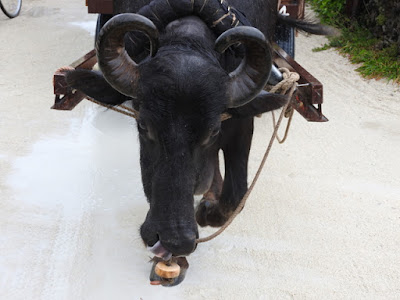目次 / Contents
1) 赤瓦と白砂 / Red Tile Roof and White Sand
2) 赤瓦とシーサー / Red Tile Roof and Shisa
1) 赤瓦と白砂 / Red Tile Roof and White Sand
このセクションの写真は、水牛車に乗って撮影したものと散策中に撮影したものです。
水牛車、公式サイト : ★
The photographs in this section were taken from water buffalo carriage, and while I walked around.
Water Buffalo Carriage ・Official Website : ★ (only in Japanese)
 街の特徴 |
| 竹富島の町並みは1987年に重要伝統的建造物群保存地区に選ばれました。 町の特徴は、赤瓦 (アカガワラ / 沖縄赤瓦 / オキナワ アカガワラ) の屋根 を備えた古い木造住宅です。 石積みやブロック塀のマイヤシは、沖縄本島ではヒンプンと呼ばれます。  Characteristics of the Town
In Taketomi Island (★), the townscape has been selected
as "Groups of Traditional Buildings" in 1987.
|

西集落 (インノタ)、
東集落 (アイノタ)、
仲筋集落 (南集落 / ナージ)
の3つの集落が島の中央部から北西部にかけてあります。
There are three villages :
West Settlement (Innota),
East Settlement (Ainota),
Nakasuji Settlement : South Settlement (Naaji)
from the centre of the Island to the northwest. |
 |
 |
| 東集落 (アイノタ) 右の建物は竹富中学校です。 East Settlement (Ainota) There is a junior high school on the right. |
 |
| 海辺のような道路 / A Road Like a Beach |
 |
なごみの塔 ; 西集落 (インノタ)
なごみの塔は、赤山公園内にあります。
高さ約6mの丘にある鉄筋コンクリートの展望台です。
Nagomi
Tower is in the Akayama park.
It is an observation stand of reinforced concrete on
a hill of about 6 m.
 下記、Wikiより。 "赤山は、平家の落人で、竹富島に流れ着いた赤山王の居城跡 であるとの言い伝えがある"  2016年9月から老朽化のため塔の頂上には登れません。 よく知られた観光スポットでしたが、現在はその景色を見ることができません。 修理の見込みは、ありません。 People haven't climbed to the top of the tower because of dangerous aging since September 2016. It was a well-known sightseeing spot, but now we cannot see the scenery. There is no prospect of repair today.  塔の高さは4.5m、歩道からの高さは約8.7m。 The height of the tower is 4.5m, the height from the sidewalk is about 8.7 m. |
 |
| 赤山公園 / Akayama Park |

塔の階段
竹富島は、サンゴが隆起してできたと聞いていました。
足元の石をみるとこんな状態で、なるほど、サンゴが土台にあることを感じさせられます。
Step to Tower
I
heard that Taketomi Island was made with coral uplift.
I
looked at the stone of my feet, there is such this condition,
indeed,
it let know me that the foundation is coral.
|

頌徳碑
以前は竹富島には医者がいませんでした。
竹盛 佐賀 (タケモリ サガ /1878-1961) 翁は、民間医療家として人々を助けました。
その功績を記念して立てられた記念日・頌徳碑 (ショウトクヒ)です。
後ろの建物は、西集落(インノタ)の集会所、'いんのた会館'です。
Shoutoku Memorial
Previously there was no doctor in Taketomi Island.
Takeshi Saga (1878 - 1961) helped people as a private healthcare professional.
It is a memorial : 'Shoutokuhi' which was made commemorating his achievements.
The building behind is the meeting hall of West Settlement (Innota) : 'Innota-kaikan'. |
 |
| 西集落の一角 / One Corner of West Settlement |
2) 赤瓦とシーサー / Red Tile Roof and Shisa
竹富島で最初に赤瓦屋根の家屋が建てられたのは1905年で、大正 (1912 - 1926) に入ってから富裕層にも普及しました。
けれども、1964年においても主屋の約4割は茅葺のままで、赤瓦の家屋の建築が盛んになったのは1970年代以降とされています。
現在は、赤瓦の街並みが竹富島の特色となり、観光の
Red Tile Roof and Shisa
In Taketomi Island, the first red tile roof was used for a house in 1905, and they spread to the richer people in Taisho Period (1912 - 1926).
However, even in 1964, about 40% of the houses were still had thatched roofs, the red roofs became more common after the 1970s.
 |
赤瓦の屋根 / Red Tile Roofs
|
"伝統的な沖縄赤瓦は、本葺瓦 (ホンブキガワラ) の系統に属する瓦で、平瓦に相当する女瓦と、丸瓦に相当する男瓦とからなる。
瓦を葺く際には、まず女瓦を並べて、その左右の継ぎ目を覆うように男瓦を被せ、台風などの強風にも耐えるように瓦どうしの隙間を漆喰で塗り固める。
このため、赤瓦を用いた屋根は、瓦の赤と漆喰の白とのコントラストが際だつ外観となる。"
Red Tile Roofs
According to Japanese Wiki about Traditional Okinawa Red Tile (translation by me)
"Traditional Okinawa red tile come into a formal tile method : Honbukigawara which mixed flat tiles and convex tiles, and consist of female tile instead of flat tile and male tile instead of convex.
When roof is made by tiles, first arrange female tiles and then cover male tiles over the joints of over female tiles so as to cover the seams on the right and left, and the gaps between tiles filled with white plaster which makes the roof stronger and protects against typhoons and so on.
Therefore roof of the red tiles shows the contrast between the red tile and the white plaster. "
瓦を葺く際には、まず女瓦を並べて、その左右の継ぎ目を覆うように男瓦を被せ、台風などの強風にも耐えるように瓦どうしの隙間を漆喰で塗り固める。
このため、赤瓦を用いた屋根は、瓦の赤と漆喰の白とのコントラストが際だつ外観となる。"
Red Tile Roofs
According to Japanese Wiki about Traditional Okinawa Red Tile (translation by me)
"Traditional Okinawa red tile come into a formal tile method : Honbukigawara which mixed flat tiles and convex tiles, and consist of female tile instead of flat tile and male tile instead of convex.
When roof is made by tiles, first arrange female tiles and then cover male tiles over the joints of over female tiles so as to cover the seams on the right and left, and the gaps between tiles filled with white plaster which makes the roof stronger and protects against typhoons and so on.
Therefore roof of the red tiles shows the contrast between the red tile and the white plaster. "
 |
| 屋根の上のシーサー / Shisa on Roof |
ときどき、相模湾の海辺の家でも見ますが、本家本元は、沖縄ですね。
Shisa
Shisa
is a statue of a legendary beast, often seen in Okinawa.Origin is said to be an ancient Orient lion.
It is installed in the gate and roof, the hill of the village etc.
Sometimes I see it even at the seaside house of Sagami Bay, but the original is Okinawa.
It is said that there are many cases where it is installed on the roof, having the meaning of an amulet that drives out evil spirits that bring disasters to homes, people and villages.
 |
阿吽のシーサー
An a-um pair
of Shisa
A-un is
the transliteration in Japanese of the two syllables "a"
and "um".
 阿 : 口を開けています。/ "a" : Open Mouth  吽 : これでも口を閉じています。 "um" : Closed Mouth (even like this) |
It is not always a pair of shisa, though it is said that there are many pairs.
 |
 このシーサーは、ひょうきんに感じます。 I feel this Shisa is jocular. |
 |
| 屋根の右になごみの塔が見えます。 I can see the Nagomi Tower on the right side of the roof. |
 |
 |
 |
| シーサーは屋根だけでなく、石垣の上(門)やいろいろな場所にいます。 Shisa is not only on the roof but also on the top of the stone wall (gate) and in various places. |




































